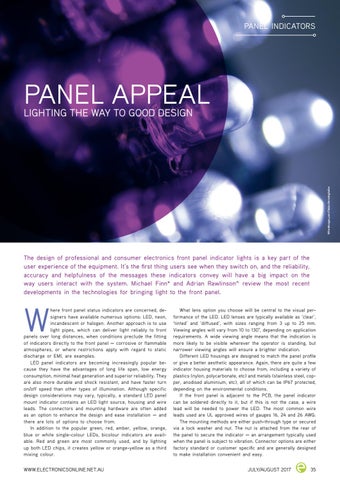PANEL INDICATORS
PANEL APPEAL
©FreeImages.com/Tristan Benninghofen
LIGHTING THE WAY TO GOOD DESIGN
The design of professional and consumer electronics front panel indicator lights is a key part of the user experience of the equipment. It’s the first thing users see when they switch on, and the reliability, accuracy and helpfulness of the messages these indicators convey will have a big impact on the way users interact with the system. Michael Finn* and Adrian Rawlinson^ review the most recent developments in the technologies for bringing light to the front panel.
W
here front panel status indicators are concerned, designers have available numerous options: LED, neon, incandescent or halogen. Another approach is to use light pipes, which can deliver light reliably to front panels over long distances, when conditions preclude the fitting of indicators directly to the front panel — corrosive or flammable atmospheres, or where restrictions apply with regard to static discharge or EMI, are examples. LED panel indicators are becoming increasingly popular because they have the advantages of long life span, low energy consumption, minimal heat generation and superior reliability. They are also more durable and shock resistant, and have faster turn on/off speed than other types of illumination. Although specific design considerations may vary, typically, a standard LED panel mount indicator contains an LED light source, housing and wire leads. The connectors and mounting hardware are often added as an option to enhance the design and ease installation — and there are lots of options to choose from. In addition to the popular green, red, amber, yellow, orange, blue or white single-colour LEDs, bicolour indicators are available. Red and green are most commonly used, and by lighting up both LED chips, it creates yellow or orange-yellow as a third mixing colour.
WWW.ELECTRONICSONLINE.NET.AU
What lens option you choose will be central to the visual performance of the LED. LED lenses are typically available as ‘clear’, ‘tinted’ and ‘diffused’, with sizes ranging from 3 up to 25 mm. Viewing angles will vary from 10 to 130°, depending on application requirements. A wide viewing angle means that the indication is more likely to be visible wherever the operator is standing, but narrower viewing angles will ensure a brighter indication. Different LED housings are designed to match the panel profile or give a better aesthetic appearance. Again, there are quite a few indicator housing materials to choose from, including a variety of plastics (nylon, polycarbonate, etc) and metals (stainless steel, copper, anodised aluminium, etc), all of which can be IP67 protected, depending on the environmental conditions. If the front panel is adjacent to the PCB, the panel indicator can be soldered directly to it, but if this is not the case, a wire lead will be needed to power the LED. The most common wire leads used are UL approved wires of gauges 16, 24 and 26 AWG. The mounting methods are either push-through type or secured via a lock washer and nut. The nut is attached from the rear of the panel to secure the indicator — an arrangement typically used when the panel is subject to vibration. Connector options are either factory standard or customer specific and are generally designed to make installation convenient and easy.
JULY/AUGUST 2017 35
